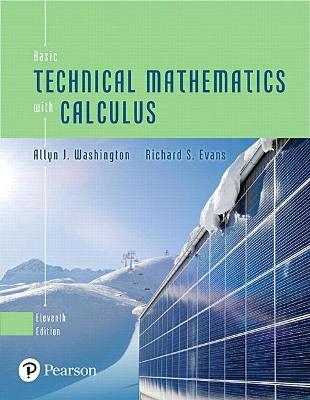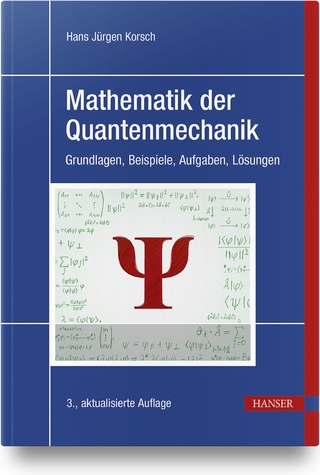
Basic Technical Mathematics with Calculus
Pearson (Verlag)
978-0-13-443773-6 (ISBN)
- Titel erscheint in neuer Auflage
- Artikel merken
For courses in technical and pre-engineering technical programs or other programs for which coverage of basic mathematics is required.
The best-seller in technical mathematics gets an “Oh, wow!” update
The 11th Edition of Basic Technical Mathematics with Calculus is a bold revision of this classic bestseller. The text now sports an engaging full-color design, and new co-author Rich Evans has introduced a wealth of relevant applications and improvements, many based on user feedback. The text is supported by an all-new online graphing calculator manual, accessible at point-of-use via short URLs. The new edition continues to feature a vast number of applications from technical and pre-engineering fields–including computer design, electronics, solar energy, lasers fiber optics, and the environment–and aims to develop your understanding of mathematical methods without simply providing a collection of formulas. The authors start the text by establishing a solid background in algebra and trigonometry, recognizing the importance of these topics for success in solving applied problems.
Also available with MyLab Math.
MyLab™ Math is an online homework, tutorial, and assessment program designed to work with this text to engage students and improve results. Within its structured environment, students practice what they learn, test their understanding, and pursue a personalized study plan that helps them absorb course material and understand difficult concepts. The MyLab Math course features hundreds of new algorithmic exercises, tutorial videos, and PowerPoint slides.
NOTE: You are purchasing a standalone product; MyLab™ Math does not come packaged with this content. If you would like to purchase both the physical text and MyLab Math, search for:
0134769600 / 9780134769608 Basic Technical Mathematics with Calculus plus MyLab Math with Pearson eText - Title-Specific Access Card Package
Package consists of:
013443773X / 9780134437736 Basic Technical Mathematics with Calculus
0134764730 / 9780134764733 MyLab Math with Pearson eText - Standalone Access Card - for Basic Technical Mathematics with Calculus
Allyn J. Washington received his Masters Degree from Brown University, Providence, Rhode Island. Allyn taught mathematics at Trinity College, Hartford, Connecticut, after graduating Phi Beta Kappa from Trinity. He was Professor of Mathematics at Dutchess Community College, Poughkeepsie, New York, where he served as the Mathematics Department Head as well as Dean of the College. Allyn is a founding member of the New York State Mathematics Association of Two Year Colleges and also a founding member of the American Mathematics Association of Two Year Colleges. He was awarded an Honorary Doctorate Degree by State University of New York. He is presently listed in Who's Who in America. The Allyn J. Washington Center for Science and Art Building is named in his honor at Dutchess Community College, Poughkeepsie, New York. Allyn has authored several textbooks in Technical Mathematics for over 50 years, including this edition of Basic Technical Mathematics with Calculus. Richard Evans received a Master’s Degree in mathematics from Binghamton University in Binghamton, New York. He is currently a professor of mathematics at Corning Community College, where he has taken an active role in the college’s governance system, including having chaired the mathematics department as well as the College Association. He is a long-standing member of the New York Mathematics Association of Two-Year Colleges and has attended and presented at many of these annual conferences. Rich has a strong background in applied mathematics, and has taken two sabbatical leaves involving real-world applications of math in business and industry. In his free time, Rich enjoys spending time with his family, playing guitar, and boating in the Finger Lakes.
Table of Contents
Basic Algebraic Operations
1.1 Numbers
1.2 Fundamental Operations of Algebra
1.3 Calculators and Approximate Numbers
1.4 Exponents and Unit Conversions
1.5 Scientific Notation
1.6 Roots and Radicals
1.7 Addition and Subtraction of Algebraic Expressions
1.8 Multiplication of Algebraic Expressions
1.9 Division of Algebraic Expressions
1.10 Solving Equations
1.11 Formulas and Literal Equations
1.12 Applied Word Problems
Geometry
2.1 Lines and Angles
2.2 Triangles
2.3 Quadrilaterals
2.4 Circles
2.5 Measurement of Irregular Areas
2.6 Solid Geometric Figures
Functions and Graphs
3.1 Introduction to Functions
3.2 More about Functions
3.3 Rectangular Coordinates
3.4 The Graph of a Function
3.5 Graphs on the Graphing Calculator
3.6 Graphs of Functions Defined by Tables of Data
The Trigonometric Functions
4.1 Angles
4.2 Defining the Trigonometric Functions
4.3 Values of the Trigonometric Functions
4.4 The Right Triangle
4.5 Applications of Right Triangles
Systems of Linear Equations Determinants
5.1 Linear Equations and Graphs of Linear Functions
5.2 Systems of Equations and Graphical Solutions
5.3 Solving Systems of Two Linear Equations in Two Unknowns Algebraically
5.4 Solving Systems of Two Linear Equations in Two Unknowns by Determinants
5.5 Solving Systems of Three Linear Equations in Three Unknowns Algebraically
5.6 Solving Systems of Three Linear Equations in Three Unknowns by Determinants
Factoring and Fractions
6.1 Factoring: Greatest Common Factor and Difference of Squares
6.2 Factoring Trinomials
6.3 The Sum and Difference of Cubes
6.4 Equivalent Fractions
6.5 Multiplication and Division of Fractions
6.6 Addition and Subtraction of Fractions
6.7 Equations Involving Fractions
Quadratic Equations
7.1 Quadratic Equations; Solution by Factoring
7.2 Completing the Square
7.3 The Quadratic Formula
7.4 The Graph of the Quadratic Function
Trigonometric Functions of Any Angle
8.1 Signs of the Trigonometric Functions
8.2 Trigonometric Functions of Any Angle
8.3 Radians
8.4 Applications of Radian Measure
Vectors and Oblique Triangles
9.1 Introduction to Vectors
9.2 Components of Vectors
9.3 Vector Addition by Components
9.4 Applications of Vectors
9.5 Oblique Triangles, the Law of Sines
9.6 The Law of Cosines
Graphs of the Trigonometric Functions
10.1 Graphs of y = a sin x and y = a cos x
10.2 Graphs of y = a sin bx and y = a cos bx
10.3 Graphs of y = a sin (bx + c) and y = a cos (bx + c)
10.4 Graphs of y = tan x, y = cot x, y = sec x, y = csc x
10.5 Applications of the Trigonometric Graphs
10.6 Composite Trigonometric Curves
Exponents and Radicals
11.1 Simplifying Expressions with Integer Exponents
11.2 Fractional Exponents
11.3 Simplest Radical Form
11.4 Addition and Subtraction of Radicals
11.5 Multiplication and Division of Radicals
Complex Numbers
12.1 Basic Definitions
12.2 Basic Operations with Complex Numbers
12.3 Graphical Representation of Complex Numbers
12.4 Polar Form of a Complex Number
12.5 Exponential Form of a Complex Number
12.6 Products, Quotients, Powers, and Roots of Complex Numbers
12.7 An Application to Alternating-current (ac) Circuits
Exponential and Logarithmic Functions
13.1 Exponential Functions
13.2 Logarithmic Functions
13.3 Properties of Logarithms
13.4 Logarithms to the Base
13.5 Natural Logarithms
13.6 Exponential and Logarithmic Equations
13.7 Graphs on Logarithmic and Semilogarithmic Paper
Additional Types of Equations and Systems of Equations
14.1 Graphical Solution of Systems of Equations
14.2 Algebraic Solution of Systems of Equations
14.3 Equations in Quadratic Form
14.4 Equations with Radicals
Equations of Higher Degree
15.1 The Remainder and Factor Theorems; Synthetic Division
15.2 The Roots of an Equation
15.3 Rational and Irrational Roots
Matrices; Systems of Linear Equations
16.1 Matrices: Definitions and Basic Operations
16.2 Multiplication of Matrices
16.3 Finding the Inverse of a Matrix
16.4 Matrices and Linear Equations
16.5 Gaussian Elimination
16.6 Higher-order Determinants
Inequalities
17.1 Properties of Inequalities
17.2 Solving Linear Inequalities
17.3 Solving Nonlinear Inequalities
17.4 Inequalities Involving Absolute Values
17.5 Graphical Solution of Inequalities with Two Variables
17.6 Linear Programming
Variation
18.1 Ratio and Proportion
18.2 Variation
Sequences and the Binomial Theorem
19.1 Arithmetic Sequences
19.2 Geometric Sequences
19.3 Infinite Geometric Series
19.4 The Binomial Theorem
Additional Topics in Trigonometry
20.1 Fundamental Trigonometric Identities
20.2 The Sum and Difference Formulas
20.3 Double-Angle Formulas
20.4 Half-Angle Formulas
20.5 Solving Trigonometric Equations
20.6 The Inverse Trigonometric Functions
Plane Analytic Geometry
21.1 Basic Definitions
21.2 The Straight Line
21.3 The Circle
21.4 The Parabola
21.5 The Ellipse
21.6 The Hyperbola
21.7 Translation of Axes
21.8 The Second-degree Equation
21.9 Rotation of Axes
21.10 Polar Coordinates
21.11 Curves in Polar Coordinates
Introduction to Statistics
22.1 Graphical Displays of Data
22.2 Measures of Central Tendency
22.3 Standard Deviation
22.4 Normal Distributions
22.5 Statistical Process Control
22.6 Linear Regression
22.7 Nonlinear Regression
The Derivative
23.1 Limits
23.2 The Slope of a Tangent to a Curve
23.3 The Derivative
23.4 The Derivative as an Instantaneous Rate of Change
23.5 Derivatives of Polynomials
23.6 Derivatives of Products and Quotients of Functions
23.7 The Derivative of a Power of a Function
23.8 Differentiation of Implicit Functions
23.9 Higher Derivatives
Applications of the Derivative
24.1 Tangents and Normals
24.2 Newton’s Method for Solving Equations
24.3 Curvilinear Motion
24.4 Related Rates
24.5 Using Derivatives in Curve Sketching
24.6 More on Curve Sketching
24.7 Applied Maximum and Minimum Problems
24.8 Differentials and Linear Approximations
Integration
25.1 Antiderivatives
25.2 The Indefinite Integral
25.3 The Area Under a Curve
25.4 The Definite Integral
25.5 Numerical Integration: The Trapezoidal Rule
25.6 Simpson's Rule
Applications of Integration
26.1 Applications of the Indefinite Integral
26.2 Areas by Integration
26.3 Volumes by Integration
26.4 Centroids
26.5 Moments of Inertia
26.6 Other Applications
Differentiation of Transcendental Functions
27.1 Derivatives of the Sine and Cosine Functions
27.2 Derivatives of the Other Trigonometric Functions
27.3 Derivatives of the Inverse Trigonometric Functions
27.4 Applications
27.5 Derivative of the Logarithmic Function
27.6 Derivative of the Exponential Function
27.7 L’Hospital’s Rule
27.8 Applications
Methods of Integration
28.1 The Power Rule for Integration
28.2 The Basic Logarithmic Form
28.3 The Exponential Form
28.4 Basic Trigonometric Forms
28.5 Other Trigonometric Forms
28.6 Inverse Trigonometric Forms
28.7 Integration by Parts
28.8 Integration by Trigonometric Substitution
28.9 Integration by Partial Fractions: Non-repeated Linear Factors
28.10 Integration by Partial Fractions: Other Cases
28.11 Integration by Use of Tables
Partial Derivatives and Double Integrals
29.1 Functions of Two Variables
29.2 Curves and Surfaces in Three Dimensions
29.3 Partial Derivatives
29.4 Double Integrals
Expansion of Functions in Series
30.1 Infinite Series
30.2 Maclaurin Series
30.3 Operations with Series
30.4 Computations by Use of Series Expansions
30.5 Taylor Series
30.6 Introduction to Fourier Series
30.7 More About Fourier Series
Differential Equations
31.1 Solutions of Differential Equations
31.2 Separation of Variables
31.3 Integrating Combinations
31.4 The Linear Differential Equation of the First Order
31.5 Numerical Solutions of First-order Equations
31.6 Elementary Applications
31.7 Higher-order Homogeneous Equations
31.8 Auxiliary Equation with Repeated or Complex Roots
31.9 Solutions of Nonhomogeneous Equations
31.10 Applications of Higher-order Equations
31.11 Laplace Transforms
31.12 Solving Differential Equations by Laplace Transforms
Appendix A Solving Word Problems Appendix B Units of Measurement Appendix C Newton’s Method Appendix D A Table of Integrals
| Erscheinungsdatum | 01.03.2017 |
|---|---|
| Sprache | englisch |
| Maße | 226 x 279 mm |
| Gewicht | 2260 g |
| Themenwelt | Mathematik / Informatik ► Mathematik ► Analysis |
| ISBN-10 | 0-13-443773-X / 013443773X |
| ISBN-13 | 978-0-13-443773-6 / 9780134437736 |
| Zustand | Neuware |
| Haben Sie eine Frage zum Produkt? |
aus dem Bereich



